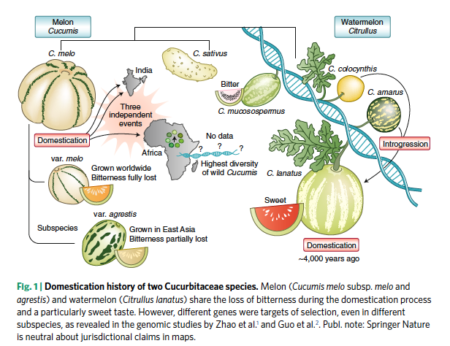- The CGIAR genebanks in the limelight.
- My friend Ahmed Amri is a big reason for the success of the above.
- The dual role of genebank managers like Ahmed.
- Feel-good nutrition stories needed.
- Rosemary gets a name change. Not many people hurt.
- Fighting food waste through breeding.
- Babylonian cooking deciphered.
- Breadfruit (and Diane Ragone) on TV.
- Maize looks doomed in Zambia. All hail sorghum.
- Food exhibition at the Fitzwilliam.
- Chiltepin culture.
- The forgotten potato of the Four Corners.
- Hey, it’s Seed Week 2019 in the UK and Ireland!
- Something similar in Kenya too, thanks to Bioversity and CCAFS.
- There’s always an apple detective story around this time of year.
Nibbles: CATIE coffee, Cajanus Down Under, Coloured wheat, Rice walk, AnGR in Uganda, Coconut sequestration, Private sector, Hawaiian taro, Going wild sustainably, DATAR, Old yeast, Pharaonic beer, Charley Rick, Liberate Diversity, Cost benefit, Catastrophe now
- The CATIE coffee collection gets a really close look.
- Pigeonpeas for Australia.
- Coloured wheat for India.
- Also in India, a rice institute opens its doors.
- A livestock genebank for Uganda.
- The coconut for the Caribbean.
- Why crop-based businesses should pay for crop conservation. Holding my breath…
- Hawaiians reclaim taro. Breathing again…
- How to use wild species sustainably.
- Diversity Assessment Tool for Agrobiodiversity and Resilience. Yeah, what we need is more software.
- 16th century beer. From Quito, the first city to brew beer in South America.
- Egyptians: I see that and raise you about 6 thousand years.
- You too can drink Leonardo’s wine. Wonder if he liked beer.
- Exploring for wild tomatoes.
- Liberating diversity.
- Agricultural R&D is in the top 3 value-for-money development interventions. Just saying…
- Seconded: “Multiplying the budget of CGIAR, the world’s largest global agricultural innovation network, would be a good start. And, in a time of great disruptions, we ought to prioritize Sustainable Development Goal 2.4, implementing resilient agricultural practices, with a greater focus on smallholder farmers in developing countries.” And 2.5!!!
Brainfood: Wild oats, Beet diversity, Durum breeding, Barley variants, Sustainable seafood, Maize systems, Pigeonpea CWR, Development & biodiversity, Local breed improvement, PA effectiveness, Root exudates, Cranberry CWR
- Developing Chloroplast Genomic Resources from 25 Avena Species for the Characterization of Oat Wild Relative Germplasm. Not many people hurt.
- Genetic diversity among cultivated beets (Beta vulgaris) assessed via population-based whole genome sequences. Genetic groups follow crop type, but with added complexity.
- Phenotypic Parent Selection within a Khorasan Wheat Collection and Genetic Variation in Advanced Breeding Lines Derived by Hybridization with Durum Wheat. That would be Triticum turgidum subsp. turanicum (Jakubz.) Á. Löve & D. Löve. These Italian researchers like the cut of its jib.
- The Fate of Deleterious Variants in a Barley Genomic Prediction Population. Avoiding the cost of domestication.
- Reframing the sustainable seafood narrative. Sustainability is about more than just ocean health, and more than just producers.
- Maize agro-food systems to ensure food and nutrition security in reference to the Sustainable Development Goals. Focus on nutritional value.
- Net Gain: Seeking Better Outcomes for Local People when Mitigating Biodiversity Loss from Development. Participation is the key.
- Determinants of breeders’ participation to an indigenous cattle breeding program. Social, family and institutional relationships are as important as distance or production systems.
- A global-level assessment of the effectiveness of protected areas at resisting anthropogenic pressures. Not very effective on average, but somewhat more effective in rich countries, and in forests.
- A Return to the Wild: Root Exudates and Food Security. The next frontier?
- Exploring the Genetic Diversity of Wild Cranberry Populations in the Upper Midwestern United States. Still work to do on the old frontier.
- Evaluation and Identification of Promising Introgression Lines Derived From Wild Cajanus Species for Broadening the Genetic Base of Cultivated Pigeonpea [Cajanus cajan (L.) Millsp.]. Some made it into the all-India initial varietal trials, no less. Take that, root exudates!
The sweetest things
There’s been a lot of action on the cucurbit domestication front lately. Hot on the heels of a comprehensive Tansley review of all the crops in the family in New Phytologist 1 now come two papers out of the Chinese Academy of Agricultural Sciences focusing on the melon and watermelon:
- Zhao, G., Lian, Q., Zhang, Z. et al. A comprehensive genome variation map of melon identifies multiple domestication events and loci influencing agronomic traits. Nat Genet 51, 1607–1615 (2019) doi:10.1038/s41588-019-0522-8.
- Guo, S., Zhao, S., Sun, H. et al. Resequencing of 414 cultivated and wild watermelon accessions identifies selection for fruit quality traits. Nat Genet 51, 1616–1623 (2019) doi:10.1038/s41588-019-0518-4.
There are press releases on each of these, of course. But the more interesting take is provided by some IPK researchers 2, who mash up the two studies. 3 And provide a nice graphic to summarize the whole thing.

The bottom line(s)? The two different subspecies of melon acquired sweet flesh through different mutations, independently but probably both in India; there was a third domestication event in Africa, but the authors had too little material at hand to say much about this. Melon and watermelon lost their bitterness through convergent evolution, and the latter has benefitted from introgression from two wild relatives, one of which was separately domesticated for its seeds.
Nibbles: Root & tuber breeding, Potato fun, Melon domestication, Maize conservation, Millet diversification, Business as usual
- A backyard breeder evaluates USDA’s potato accessions. Among other things.
- The Onion roasts potatoes.
- How melons got sweet.
- Mexican Senate considers in situ/on farm conservation areas for maize.
- Millets for climate change resilience in India.
- Business for biodiversity. Yeah, right.